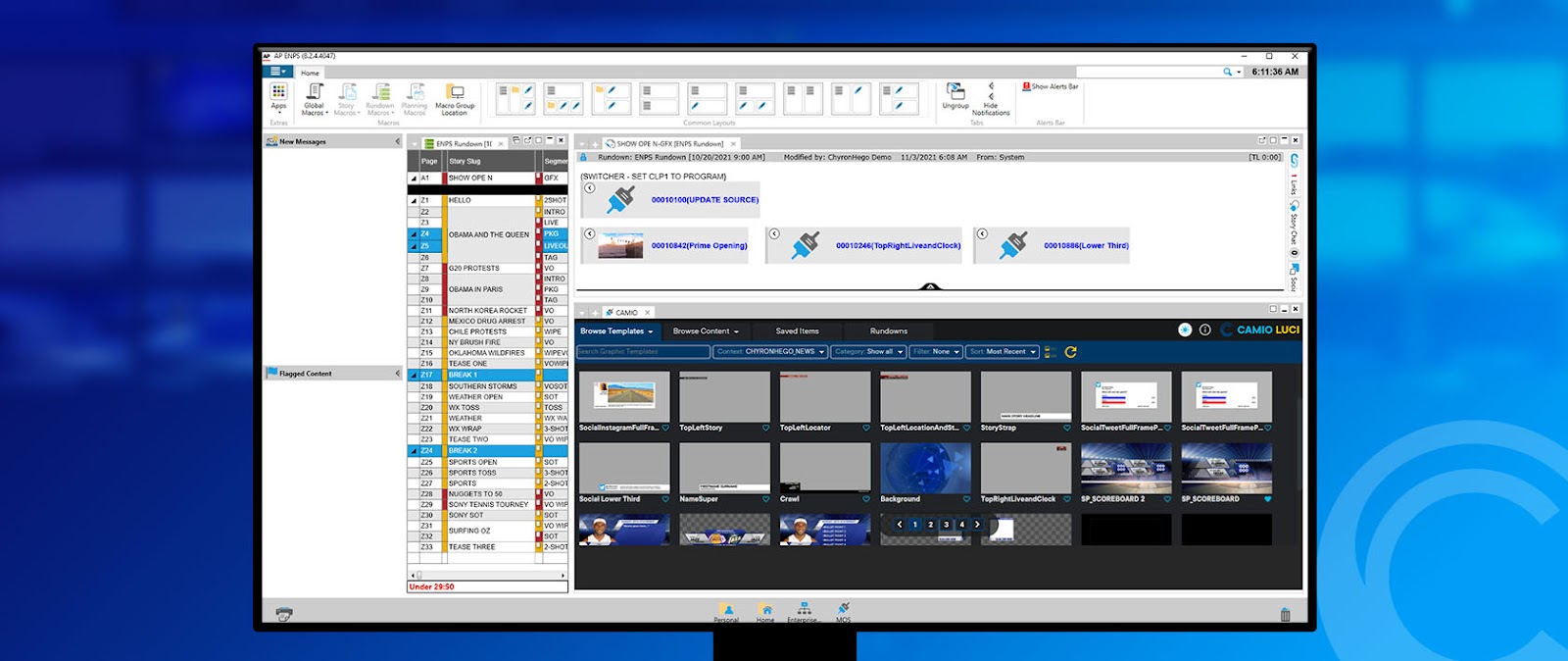
How CAMIO Empowers Producers and Journalists To Bring Better Stories to Air
Think about the tasks you perform every day to help create and deliver interesting, timely, professionally produced stories to your audience. Now imagine you had one tool — conveniently accessible within your newsroom MOS interface — that simplifies every aspect of graphics asset management across the full news production workflow.
That tool is CAMIO. Whether you’re a journalist or producer, CAMIO empowers you from the time a major news event occurs to the moment that story goes to air, gets published to your digital and social channels, or gets edited into a longer, more complex piece.
Providing fast, flexible template-based graphics creation and extensive graphics management capabilities, CAMIO streamlines news production and buys you time — time you can use to get a story out more quickly or to add that extra detail or finishing touch that sets your news organization apart from the competition.
What does this look like in everyday practice? Let’s start with the news event.
A Typical Breaking News Event
Say one afternoon a car drives off a bridge and into a river, and a good Samaritan dives into the water and saves everyone. A bystander happens to capture all this on their smartphone and then posts the video to social media. It quickly blows up, going viral. Those are the first images you see, well before the ENG crew arrives on the scene.
You gather context from the growing number of social posts and comments about the event. You follow the right hashtags, look at posts from the surrounding geographic area, and begin grabbing and sourcing photos and video. Right about this time, as you start piecing together the story and confirming the details, you’re sending off the first graphics requests or building them yourself. You need to get some visuals ready fast while making sure they have the same smart look and feel of all your other news graphics.
Develop Your Entire Story in the NRCS
Without leaving the NRCS interface, you use CAMIO to find key visual assets that help you tell the story. You can add keywords and other metadata to newly acquired video clips and images. You can quickly input information that will populate a lower-third, perhaps for an eyewitness interview or to identify video captured as the event unfolded. Within seconds you can create an over-the-shoulder graphic or a full-screen graphic with a quote from a public safety official or a summary of what you know so far. You can even access and use elements used in a virtual reality or augmented reality set, if your station has implemented those technologies.
As you get further information about the people involved and the site of the event, you may want to explore your station’s archived video and photos to see if you already have any images that can add further character and color to the story. If you’re part of a larger station group using CAMIO, you can look for any prior reporting on the people involved. (Maybe that good Samaritan has performed other good deeds while living in another city!) If your CAMIO system is tied into AXIS graphics order management, you can quickly locate images and maps to show viewers what happened, where, and how.
[READ: Streamlined News Graphics: What Are You Missing?]
Newsroom-Driven Graphics Creation
You can orchestrate the creation of all these graphics without leaving your desk. And, while you build this breaking news story, the resources you pull and graphics your team creates all become available to the edit bay for inclusion in a larger package or longer-form story. The reverse is true too, thanks to seamless integration between your live on-air production tools and your editing and post tools via CAMIO. You can share assets back and forth effortlessly, and you don’t need to run down the hall or step into another department to make it happen. You can easily pull from multiple sources and send graphics along for playout live on air, posting on a digital or social media platform in just the right format, or inclusion in another journalist’s or editor’s work.
As is often the case, this is an evolving story, and new details emerge that warrant further coverage the next day on your morning news show. No worries! You’ve already done most of the work. CAMIO makes it easy to “re-skin” all those graphics created the night before so that they match the color scheme and branding specific to that morning show. Within moments, you’ve got a full array of graphics that need just a small amount of updating before they’re ready to go. Rather than re-make the assets, you basically perform an instantaneous update, and assets are automatically given the appropriate characteristics — color, typeface and size, branding elements, etc.
Empower Your Producers and Journalists
In addition to giving you fast, easy access to the graphics you need, CAMIO facilitates more effective and efficient collaboration in getting that news story to air. Standard graphics templates allow just about anyone to create the basic visual elements for your story, and this allows the graphics team to focus on more complex and creative visuals that take reporting to the next level. Everyone gets more of the time they need to build a great story.
Because work order management is built into CAMIO, you’re able to keep an eye on all of the moving parts, identify any bottlenecks, and nudge or intervene where necessary. You and the rest of your team can focus on doing what you do best, all working together efficiently — and likely be the first to deliver a timely, compelling, and polished-looking news story to air.
To learn more about how CAMIO 5.0 can empower your newsroom, click here.


